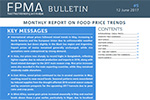FAO price data and analysis
FAO provides a range of information on prices, including:
- international prices and the FAO Food Price Index (FFPI)
- domestic prices accruing to agricultural producers and consumer food price indices from FAOSTAT
- wholesale and retail prices from the FAO’s Global Information and Early Warning System (GIEWS) Food Price Monitoring and Analysis (FPMA).
- changes in daily, weekly and monthly food prices and nowcasts from the FAO Data Lab.
Data on international prices
International prices are comprised of both export and import prices. Export prices are determined in markets for products intended for delivery outside a country’s borders. Export markets are also described as terminal wholesale markets, where the valuation of the product is made as free-on-rail, or free-alongside-ship or free-on-board (denoted by f.o.b. prices). Import prices are prices of goods purchased inside a country but produced outside of its boundaries.
The FAO Food Price Index (FFPI) is a measure of international prices for a basket of traded (exported) agricultural commodities. It consists of the average of five commodity group price indices weighted by the average export shares of each of the groups in 2014-2016.
Data on domestic prices
The FAOSTAT domain on Agricultural Producer Prices and Producer Price Index reports official national level data received from FAO Members on prices their farmers obtain. The domain in 2021 reports annual prices from 1991 to the year prior to publication for 160 countries and for about 262 products, and monthly prices from January 2010 to the year prior to publication for over 60 countries and for about 200 products. Producer Price Indexes are also provided, which measure price inflation at the farm-gate level. Farm-gate prices refer to the point in time in which a produce leaves the farm; hence they do not cover costs beyond the farm gate, such as transportation costs to markets or the first point of sale, warehousing costs, processing costs or other charges for selling the produce.
![]() FAOSTAT Producer Prices – Annual
FAOSTAT Producer Prices – Annual
![]() FAOSTAT Producer Prices – Monthly
FAOSTAT Producer Prices – Monthly
![]() FAOSTAT Producer Price Indices – Annual
FAOSTAT Producer Price Indices – Annual
Wholesale prices of agricultural products are the prices at which wholesalers sell products in bulk quantities to retailers, manufacturers and industrial users. These prices include transportation charges after leaving the farm gate, incidental expenses and the wholesaler’s profit margin.
Retail prices of agricultural products are the prices at which the products are sold to the end consumer for consumption, and include expenses that the retailer incurs, plus a profit margin.
The FAOSTAT Consumer Price Indices dataset includes indices that refer to all consumption items (or general Consumer Price Indices (CPIs)) and indices that refer to food (or Food - Consumer Price Indices (Food-CPIs)). Consistent time series are available from January 2000 at country level, together with regional and global food CPIs compiled by FAO using household expenditure weights to aggregate across countries. These indices measure the price change between the current and reference periods of the average basket of goods and services purchased by households.
![]() FAOSTAT Consumer Price Indices and Food Price Indices
FAOSTAT Consumer Price Indices and Food Price Indices
The FAO Data Lab monitors daily food prices to warn about possible anomalous dynamics , by means of analytical and visual tools. Using daily prices on 14 commodities collected from Numbeo and other high frequency indicators, the Data Lab nowcasts official food Consumer Price Indices (Food CPI).
![]() FAO Data Lab high frequency food price tool
FAO Data Lab high frequency food price tool








